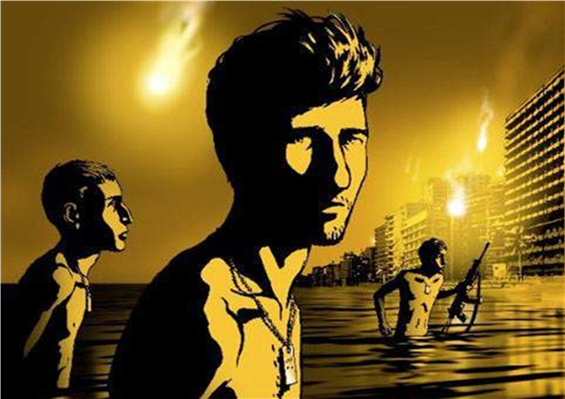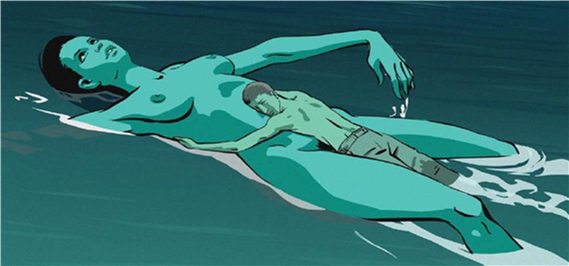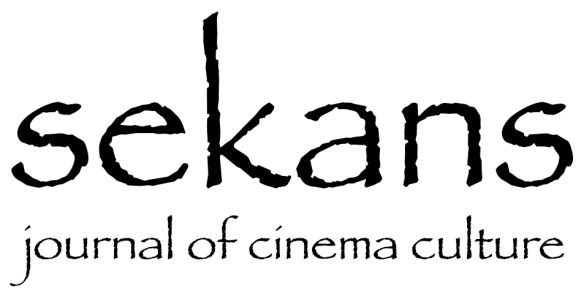WALTZ WITH BASHIR: CAN A FRANK CONFESSION BE THE APOLOGY FOR HISTORIC DESTRUCTIONS?
A. Kadir Güneytepe
Ari Folman is a documentary film-maker from Israel, who normally doesn’t work on animations. However, in Waltz with Bashir, he has successfully used the animation in order to re-fictionalize the memories, delusions, fantasies, possibilities, the past and the present. Actually, there seems to be no other way to make this film easier except than making it an animation. The animation is generally assigned different meanings since it is mostly related to cartoons; however, animation is also a successful way to express the historical destructions related to humanity. Furthermore, it can also be used to describe the state of humanity by making both contemporary and future predictions based on current position of humanity. Sometimes, it can also be fictionalized humorously or cunningly. We can give the film WALL-E by Andrew Stanton (2008) as an example which expresses the consumerist society impressively and criticizes it radically.
Folman fictionalized Waltz with Bashir as a traditional documentary. He visits his old friends from army; he tries to bring together the things he saw and recalled. Eventually, with the power of freedom that he gained from animations, he visualizes the things he was told, even the nightmares. In this way, Folman tried to make both himself and the world face the reality of war, the pain it left behind, and especially the alienation of Israel society with that situation. The world had taken a back seat and watched silently, just like it has done in other genocides. The question of how guilty the people are is always left obscure. Folman makes a reference to this situation with his visual documentary. As well as the ones who pull the trigger, there are also others who have moral responsibility or are guilty.
Waltz with Bashir is a very staggering production. It depicts that Israel condoned Sabra and Shatila1 massacre carried out by the Cristian Phalanges during the Lebanese War in 1982 and the social amnesia of Israel itself was perhaps behind all of these. In Waltz with Bashir, which is a kind of fictional autobiographical documentary, Folman shows that the Israeli people have consciously forgotten the massacre in a state of social amnesia; thus, he tries to make his own generation face with the doom that they themselves have created. This film, in a way, is an effort to reconstruct the lost memories, dreams, war traumas and the surrealistic reality that was engraved in subconsciously. Although the terror of the massacre was suppressed and buried deep in the Israelis’ minds in the last quarter century, according to Folman, that could not be fully achieved. Thus, the experiences can reappear at any moment as they are still close to the surface of their conscious.
Horrible events that lead to massacres are revealed in the film by using the semi-fictional re-constructive method somewhere between the oral history and psychoanalysis. A very realistic rotoscope2 animation method was used in the film; however, in an interview, Folman told that it was a mixture of Flash, hand-drawn animation and 3D original drawings. The live-actions on video-tape were transformed to the scenes that the reality is seen as two or three dimensional, and that is digitally bizarre and dreamlike. The planes and surfaces vibrate more, and the colors become more concrete, sharp, and bright. It looks like a long delusion and it is perfect in terms of reflecting the trauma of the Folman’s memories that flood back. However, does it mean that the tragic situation represented by animation may not be as effective for the audience as the live-action scenes and the connection that the animation makes with people may not be enough? Does the power of animation also turn into its own weakness?
One of his friends from army (Boaz Rein) visits the middle-aged director. They drink beer together and this man mentions of a repetitive and very uncomfortable dream that he is being attacked by 26 wild dogs, which is actually the opening scene of the film.

The rageful dogs which are successfully characterized move across and gathered in front of the man’s window. Then the man starts explaining how this dream is related to the 1982 Lebanon War. This meeting shows Folman that he doesn’t recall anything about that period. He realizes that not only he was not close to the camp places but also he doesn’t recall anything about the war itself. He then tries to recover his memories by tracing his companions in that period. For Folman, this is also going to be a travel which he confronts the past.

In his mind, there is actually no information related to those moments. Only thing he recalls is actually not a memory, but a dream or a delusion of the soldiers coming out of the sea one by one and this is actually the trace of the live-action scenes in Folman’s mind which we are going to see at the end of the film. In other words, this is perhaps the trauma that Folman’s testimony to those events have produced or left behind. In this delusion, like a slow-motion imitation of a military extraction or the arrival of amphibian creatures, skinny and frail new adolescent soldiers lie on their back in stagnant water with only the heads and fingertips outside. This still water is like a resemblance of a uterus. They come out of the water one by one. The sky is pale but oddly yellow. This color is used at the film’s most important moments, as the color of military operations and the color of weapons’ flames. As if it is the color of sovereignty and the trauma it caused. Then Folman consults his psychiatrist friend about this dream, his friend tells him that the only way out is to reach his friends who served with him, and to reveal and face the memories about what was happened in Lebanon.
His friends tell him some unsettling and brutal things about blood and terror. Anyhow, what they say does not represent the actual truth; they tell the stories only from their own perspectives, as how they want to see things. Just like in the Rashomon3. People want to forget the bad things and they want to recall the good things even if those are actually made up. One of them tells that he recalls he is sailing on the “Love Boat” and a big naked woman takes him with her. Despite all the evil things happening, it seems like there is a desire to return to the safe zone, because he is just lying on the woman’s womb and watching around drowsily. Another one says a Palestinian child attacked his troop with bazooka in a fruit garden; the other says he was almost killed in an ambush and survived miraculously by swimming....

All of these slowly allow Folman to remember his memories about Sabra and Shatila. Was he there? Could he be there? If so, how close was he? This confusion was perhaps created to reveal the dark side of the war and to focus on the personal traumas, or perhaps for not to be accused of war crimes. And perhaps it was created in order to show that, because of television, people distance themselves from the actual events and become alienated, they are desensitized as if they have no concern and they are disoriented.
Eventually the film takes him to the crime scene, and it makes a brave turn from animation into television news. However, the tragedy that is shown in detail with the animation has already enough impact, even before showing the actual events; therefore, this part seems to be a little bit redundant. Moreover, it is interesting that the Palestinians have no name, they are represented anonymously and also, they do not talk. The fact that they are shown as brazen victims and the demonstration of Israeli soldiers as victims is one of the points that can be criticized. The facial reactions of Palestinians and what they are going through are not quite shown except the actual scenes at the end of the film whereas, the misery and despair of the Israeli soldiers are shown explicitly in the film. The human side of the Palestinians is also not shown. Hence, it looks like the film is causing a kind of alienation to what Palestinians go through, as well. Depicting the misery of Palestinians might have been necessary in terms of clarifying the same human drama from a different perspective. Another criticism is that a Palestinian mother cannot be told by such equality that what she has lost is more difficult and tragic than an Israeli adult should cope with. We don’t hear any statement coming from any Palestinian. In this regard, Palestinians are shown as if they are only a fraction of those times or a complementary of that event.
In addition to all these, the reasons for occupation, the destruction it has created, and the role of Israel seem to be hidden behind the confusion and fear of the young and naive 19-year-old soldiers. And this makes the film deprive of a political background and only focus on the psychological process; hence, there can be another criticism that it is misleading to show only the Israeli soldiers as experiencing the actual damages. The only message film gives is that the war is a terrible thing because it causes traumas; however, only its traumatic effects on the soldiers is taken as important and not its effects on masses. It can be seen as escaping from facing the actual responsibility. In a sense, it avoids questioning the current government and its ongoing actions and it remains as a superficial relief and confession. It is interesting that Ariel Sharon who is responsible for the massacre had been elected as the prime minister while the film was awarded even in Israel. Furthermore, the support given to the similar operations going on in Gaza is also a remarkable controversy while the film was awarded. The film, in this sense, acts as a mass therapy.
1 Sabra and Shatila massacre was killing of hundreds of people including children (between 750 and 3500 people) by the pro-Israel and extreme right wing militia of Christian Phalangists by attacking the Palestinian refugee camps called Sabra and Shatila in the West Beirut. It is revealed after the massacre that Ariel Sharon, the old prime minister of Israel, had a role in this massacre. According to BBC, Israel Parliamentary Investigation Committee regarded Sharon as responsible for this massacre, and consequently Sharon resigned from his duty in Ministry of Defense.
2 It is a technique that is used frame by frame for each motion in order to produce a realistic action. For this reason, it is quite hard to apply. If there are 24 frames in a one second film, 240 pictures must be produced for a 10 seconds scene.
3 Rashomon is a 1950 Japanese dramatic film. Its original name is Rashōmon. It was directed by Akira Kurosawa and was adapted by two short stories called Roshomon and In A Grove written by Ryūnosuke Akutagawa (1892-1927) who is regarded as the father of Japanese short story. This film also introduced the director to the West world. This psychological drama was built on the frailty of people. A samurai passing by the forest with his wife in the 12th century Japan is attacked and killed by a bandit, and his wife is raped. The bandit gets caught but his statement and the woman’s statement are totally different from each other. With the help of a psychic who comes into play to solve this problem, the samurai tells the story, but his story is totally different as well. The statement of woodsman again clashes with the others. Who tells the truth in this case where everybody’s “truth” is different from each other and the crime has four inconsistent but convincing versions? The humans are weak, so they lie even to themselves and people want to forget the bad things and believe the good even if it is a lie. This way is easier. It is the main point of the film.
References
Bradshaw, Peter. “Waltz With Bashir”, The Guardian, November 21, 2008
Ebert, Roger. “Waltz With Bashir”, rogerebert.com, January 21, 2009
Antaun, Naira. “Film Review: “Waltz With Bashir””, The Elektronic Intifada, February 19, 2009
Robinson, Tasha. “Waltz With Bashir”, A.V. Club, December 24, 2008
“Film review: Waltz with Bashir – feeling good about feeling bad”, Revolution, December 8, 2008
“Waltz With Bashir”, tr.wikipedia.org
Published in SEKANS Sinema Kültürü Dergisi, August 2017, Issue e5, pp. 160-165
Translated by İzel Asal
This email address is being protected from spambots. You need JavaScript enabled to view it.
